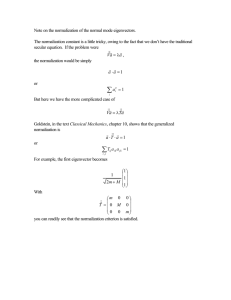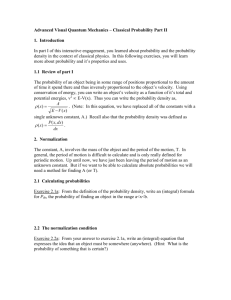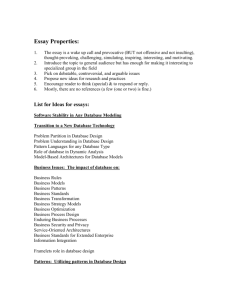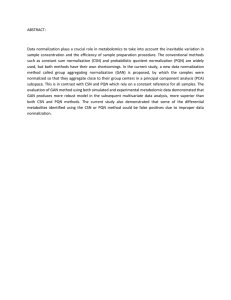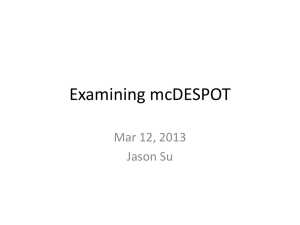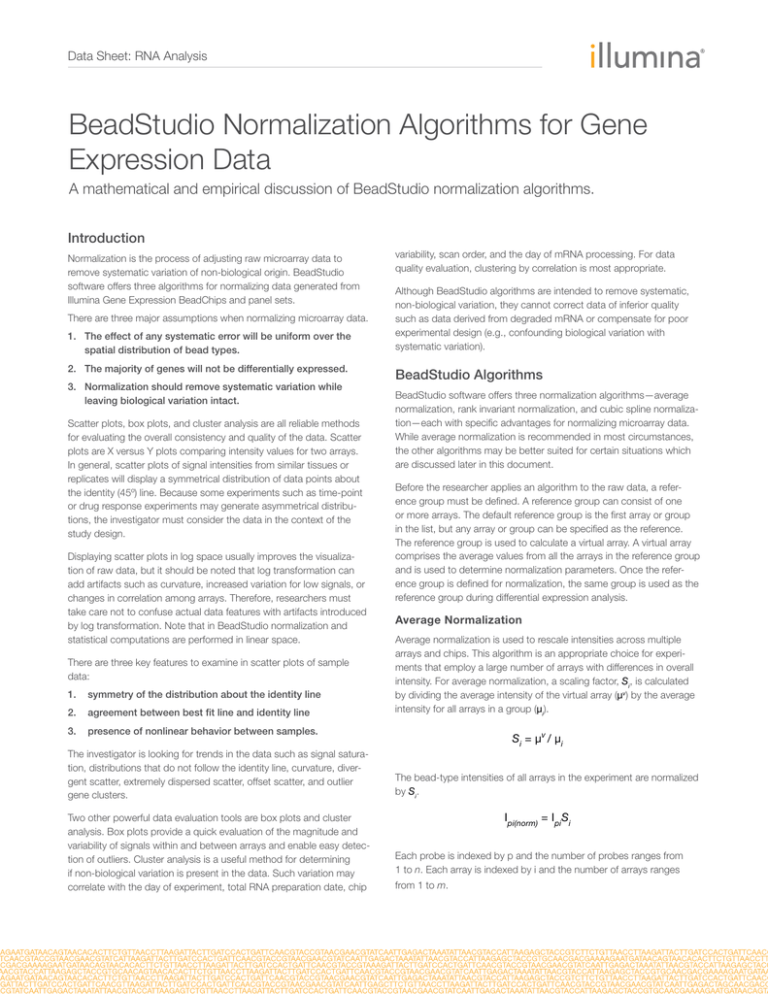
Data Sheet: RNA Analysis
BeadStudio Normalization Algorithms for Gene
Expression Data
A mathematical and empirical discussion of BeadStudio normalization algorithms.
Introduction
Normalization is the process of adjusting raw microarray data to
remove systematic variation of non-biological origin. BeadStudio
software offers three algorithms for normalizing data generated from
Illumina Gene Expression BeadChips and panel sets.
There are three major assumptions when normalizing microarray data.
1. The effect of any systematic error will be uniform over the
spatial distribution of bead types.
2. The majority of genes will not be differentially expressed.
3. Normalization should remove systematic variation while
leaving biological variation intact.
Scatter plots, box plots, and cluster analysis are all reliable methods
for evaluating the overall consistency and quality of the data. Scatter
plots are X versus Y plots comparing intensity values for two arrays.
In general, scatter plots of signal intensities from similar tissues or
replicates will display a symmetrical distribution of data points about
the identity (45º) line. Because some experiments such as time-point
or drug response experiments may generate asymmetrical distributions, the investigator must consider the data in the context of the
study design.
Displaying scatter plots in log space usually improves the visualization of raw data, but it should be noted that log transformation can
add artifacts such as curvature, increased variation for low signals, or
changes in correlation among arrays. Therefore, researchers must
take care not to confuse actual data features with artifacts introduced
by log transformation. Note that in BeadStudio normalization and
statistical computations are performed in linear space.
There are three key features to examine in scatter plots of sample
data:
1. symmetry of the distribution about the identity line
2. agreement between best fit line and identity line
variability, scan order, and the day of mRNA processing. For data
quality evaluation, clustering by correlation is most appropriate.
Although BeadStudio algorithms are intended to remove systematic,
non-biological variation, they cannot correct data of inferior quality
such as data derived from degraded mRNA or compensate for poor
experimental design (e.g., confounding biological variation with
systematic variation).
BeadStudio Algorithms
BeadStudio software offers three normalization algorithms—average
normalization, rank invariant normalization, and cubic spline normalization—each with specific advantages for normalizing microarray data.
While average normalization is recommended in most circumstances,
the other algorithms may be better suited for certain situations which
are discussed later in this document.
Before the researcher applies an algorithm to the raw data, a reference group must be defined. A reference group can consist of one
or more arrays. The default reference group is the first array or group
in the list, but any array or group can be specified as the reference.
The reference group is used to calculate a virtual array. A virtual array
comprises the average values from all the arrays in the reference group
and is used to determine normalization parameters. Once the reference group is defined for normalization, the same group is used as the
reference group during differential expression analysis.
Average Normalization
Average normalization is used to rescale intensities across multiple
arrays and chips. This algorithm is an appropriate choice for experiments that employ a large number of arrays with differences in overall
intensity. For average normalization, a scaling factor, Si, is calculated
by dividing the average intensity of the virtual array (μv) by the average
intensity for all arrays in a group (μi).
3. presence of nonlinear behavior between samples.
The investigator is looking for trends in the data such as signal saturation, distributions that do not follow the identity line, curvature, divergent scatter, extremely dispersed scatter, offset scatter, and outlier
gene clusters.
Two other powerful data evaluation tools are box plots and cluster
analysis. Box plots provide a quick evaluation of the magnitude and
variability of signals within and between arrays and enable easy detection of outliers. Cluster analysis is a useful method for determining
if non-biological variation is present in the data. Such variation may
correlate with the day of experiment, total RNA preparation date, chip
Si = μv / μi
The bead-type intensities of all arrays in the experiment are normalized
by Si.
Ipi(norm) = IpiSi
Each probe is indexed by p and the number of probes ranges from
1 to n. Each array is indexed by i and the number of arrays ranges
from 1 to m.
Data Sheet: RNA Analysis
Rank Invariant Normalization
expressed, or that there is a large difference in intensity among arrays,
the user should consider cubic spline normalization.
Rank invariant normalization is an appropriate selection if the investigator can assume that a reasonable percentage of the genes in an
experiment are not differentially expressed (i.e., rank invariant).
Cubic Spline Normalization
Cubic spline normalization is implemented to remove curvatures observed in scatter plots that arise from nonlinear relationships between
samples or groups of samples when plotted in log space. This method
initially divides the intensity distribution into a group of quantiles
consisting of a similar number of gene intensities. Quantiles (q) are
determined by letting
For rank invariant normalization, a subset of probes whose rank does
not change across the experiment are identified and serve to define
the normalization parameters. To determine if a gene is rank invariant,
the intensities from the low rank (50th percentile) and the high rank
(90th percentile) are considered to be rank invariant if the absolute
value of the change in relative rank (r) between the gth gene in the ith
sample and the gth gene in the virtual sample is less than 0.05. Here
rgv is the rank of gene g in the virtual array v and rgi is the rank of gene
g in array i.
qi = (i - 0.5)
N
where i equals array 1,2,3,...m and N is equal to total number of quantiles.
|rgi - rgv | < 0.05
rgv
By letting qi be a vector of N quantiles, then
Let i (1,2,3...m) enumerate all samples used in the experiment. Then
for array i, normalization coefficients (ai,bi) can be computed using an
iteratively reweighted least squares fit.
where Nprobes is the number of probes represented on a sample array.
Using the scaling factor, the intensities from the sample array in a given
quantile are adjusted to match the intensities from the virtual array. For
two samples to be normalized to each other, cubic spline normalization scales the kth quantile of the sample array such that it is equal to
the kth quantile of the virtual array. This scaling is repeated for each
quantile. Genes with values that lie between quantiles are adjusted
by interpolation of the neighboring quantiles. While this normalization
is meant to address nonlinear relationships between samples in log
space, it can also be used as a general normalization method.
yv = ai yi + bi
Here yv and yi are intensity vectors of probes corresponding to the
rank invariant set of probes on virtual array v and i, respectively. The
Tukey bisquare weight function with the tuning constant set at 4.685
provides 95% efficiency when errors are normally distributed while
maintaining protection against outliers. The standard deviation of errors is estimated using the median absolute deviation.
Normalization of titration Data Sets in
BeadStudio
The rank invariant normalization algorithm normalizes intensities and
subtracts background through the following equation.
yi
new
N = max(15, Nprobes )
100
= yi - bi
ai
Rank invariant normalization is more robust to outliers than the
average normalization method. However, if it is known that a large
percentage of the genes in an experiment may be differentially
For the purpose of demonstrating the results of normalization using
the three algorithms available in BeadStudio, Illumina scientists analyzed two titration data sets. The first titration experiment profiled five
input concentrations of human total RNA and shows the effects of normalization on data with nonlinear characteristics. The second titration
data set provides a biologically relevant example of the stability of high
quality data to BeadStudio normalization algorithms using four
Figure 1: Effect of Average, Rank Invariant, and Cubic Spline Normalization On Nonlinear Data
Raw Data
Average Normalization
15
0
A
B
C
Array
D
E
20
Log 2 Intensity
Log 2 Intensity
5
10
10
5
5
A
B
C
Array
D
E
15
10
0
5
-5
0
Cubic Spline Normalization
Rank Invariant Normalization
20
15
10
Log 2 Intensity
Log 2 Intensity
15
A
B
C
Array
D
E
A
B
C
Array
D
E
Data Sheet: RNA Analysis
MAQC1 samples: 100% Brain total RNA, 100% Universal RNA from
Stratagene, 25% Universal-75% Brain, and 75% Universal-25% Brain.
data, cubic spline normalization achieves the greatest improvement in
symmetry, and the best agreement between the identity and best fit line.
Total RNA Titration Data
MAQC Titration Data
For the human total RNA titration experiment, five cRNA samples
were hybridized on a single Human-6v1 BeadChip. The five samples
were placed on arrays A (highest concentration) through E (lowest
concentration). The box plots for the average signal intensities for all
the arrays show that the intensities diminish from array A to array E
(Figure 1). Although both average normalization and rank invariant
normalization scale the data, average normalization scales all the arrays tighter around the mean of the arrays. Cubic spline normalization
rescales all arrays so that the means are equal.
The MAQC data were analyzed to demonstrate the results of BeadStudio normalization on biologically relevant samples. The samples
were assayed on four Human-6v1 BeadChips. In practice, when the
data are of high quality, different normalization methods do not result in
drastically different analysis outcomes. The robustness of high-quality
data is illustrated with box plots, scatter plots, clustering, and differential gene expression analysis of the MAQC sample profiles (Figures 3,
4, and 5, and Table 1). The box plots show considerable similarity
between average normalization and cubic spline normalization in terms
of scaling the median and generating a unifrom interquartile range. In
comparison, a larger degree of variability remains after rank invariant
normalization. Scatter plots of the MAQC data also reveal only minor
differences in the results of the three normalization algorithms, with
A log scatter plot displaying the intensity signals from array A versus
array B demonstrates the nonlinear relationship of the raw data and
reveals a significant curvature in the data set. Additionally, the raw data
set is displaced from the identity line, and the best fit line is offset and
skewed from the identity line. (Figure 2). When adjusting nonlinear
Figure 2: Effect of Average, Rank Invariant, and Cubic Spline Normalization on Nonlinear Data
Average Normalization
Raw Data
105
Array B (log10 Intensities)
Array B (log10 Intensities)
104
104
103
103
102
101
102
102
103
101
104
102
Array B (log10 Intensities)
10
5
Array B (log10 Intensities)
105
Array B (log10 Intensities)
104
Cubic Spline Normalization
Rank Invariant Normalization
104
103
102
101
103
Array B (log10 Intensities)
104
103
102
101
102
103
104
Array B (log10 Intensities)
105
102
103
104
Array B (log10 Intensities)
The data were filtered by the detection p-value < 0.01. The identity line and two-fold boundaries are denoted in red. The best fit line is blue.
105
Data Sheet: RNA Analysis
Intensity
500 1000 1500 2000 2500
Intensity
Rank Invariant Normalization
Cubic Spline Normalization
3
5
7
9
11 13 15 17 19
1
Array
3
5
7
9 11 13 15 17 19
0
1
0
0
0
500 1000 1500 2000 2500
Intensity
Average Normalization
500 1000 1500 2000 2500
100 150 200 250 300
Raw Data
50
Intensity
Figure 3: Effect of Average, Rank Invariant, and Cubic Spline Normalization on High-Quality Data
1
Array
3
5
7
9
11 13 15 17 19
1
Array
3
5
7
9
11 13 15 17 19
Array
Scale differs from raw to normalized data because normalized data were filtered by detection p-value < 0.05.
Figure 4: Effect of Average, Rank Invariant, and Cubic Spline Normalization on High-Quality Data
Average Normalization
Raw Data
100% Brain (log10 Intensities)
100% Brain (log10 Intensities)
105
104
103
102
104
103
102
101
102
103
101
104
100% Universal (log10 Intensities)
102
103
104
100% Universal (log10 Intensities)
Rank Invariant Normalization
Cubic Spline Normalization
104
100% Brain (log10 Intensities)
100% Brain (log10 Intensities)
105
103
102
101
104
103
102
101
101
102
103
100% Universal (log10 Intensities)
104
101
102
103
100% Universal (log10 Intensities)
The data were filtered by the detection p-value < 0.01. The identity line and two-fold boundaries are denoted in red. The best fit line is blue.
104
Data Sheet: RNA Analysis
average and cubic spline normalization showing the closest similarity
in performance (Figure 4).
small differences in correlation results within a rearrangement of the
samples in this cluster.
Hierarchical clustering shows that the four MAQC sample groups
partition distinctly according to biological variation and do not show
appreciable differences with regard to composition and correlation
as a function of normalization (Figure 5). The cluster consisting of the
universal total RNA samples shows the highest variability in sample
order. However, the correlation within this group is extremely tight and
Finally, differential analyses were conducted between the MAQC pure
brain and universal RNA groups to determine the impact of applying different normalizations. The Illumina Custom error model with
false discovery rate (FDR) correction was applied to data sets after
normalizing by each algorithm separately. The resulting lists of genes
Figure 5: BeadStudio Dendrograms of MAQC Samples Before and After Normalization
Raw Data
Average Normalization
Rank Invariant Normalization
Cubic Spline Normalization
Data Sheet: RNA Analysis
Table 1: Analysis of BeadStudio Normalization on Pure Brain and Pure Universal MAQC Titration Samples
Normalization
Algorithm
Number of Differentially
Expressed Genes (p < 0.001)
Analysis
% Overlap in the
number of genes
Average
12,489
Average versus Rank Invariant
88%
Rank Invariant
12,720
Rank Invariant versus Cubic Spline
92%
Cubic Spline
12,671
Cubic Spline versus Average
96%
were analyzed to determine the extent of overlap among the various
normalizations (Table 1). Overall, there is considerable overlap among
gene lists, illustrating that conclusions drawn from differential expression analysis using high-quality data should not change drastically as a
function of normalization.
Conclusion
The results of these analyses indicate that average normalization and
cubic spline normalization algorithms perform most similarly when the
data are of high quality. Further, rank invariant normalization seems to
be more conservative with regard to the magnitude of the adjustment it makes to the data. When the data are of high quality, different
normalizations will likely not lead to large differences in the results of
statistical analysis, class discovery, or class prediction methods. In
general, Illumina recommends using average normalization; however,
when there are nonlinear associations among arrays, cubic spline
normalization is a more appropriate choice.
References
1.
MAQC Consortium, Shi L, Reid LH, Jones WD, Shippy R, et al.
(2006) The MicroArray Quality Control (MAQC) project shows interand intraplatform reproducibility of gene expression measurements.
Nat Biotech 24(9):1151-1161.
Illumina, Inc. • 9885 Towne Centre Drive, San Diego, CA 92121 USA • 1.800.809.4566 toll-free • 1.858.202.4566 tel • techsupport@illumina.com • illumina.com
For research use only
© 2011 Illumina, Inc. All rights reserved.
Illumina, illuminaDx, Solexa, Making Sense Out of Life, Oligator, Sentrix, GoldenGate, GoldenGate Indexing, DASL, BeadArray,
Array of Arrays, Infinium, BeadXpress, VeraCode, IntelliHyb, iSelect, CSPro, GenomeStudio, Genetic Energy, HiSeq, HiScan, TruSeq,
and Eco are registered trademarks or trademarks of Illumina, Inc. All other brands and names contained herein are the property of
their respective owners. Pub. No. 470-2007-005 Current as of 03 January 2011.


